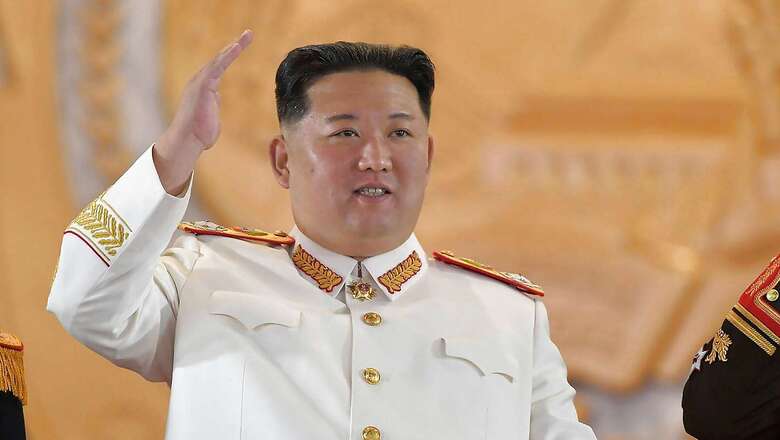
views
The Korean Peninsula has been a flashpoint for over seven decades. Tensions have ebbed and flowed but a solution has been elusive. Meanwhile, resource-rich North Korea has become an international pariah. Economically impoverished and an absolute dictatorship, it has been keeping its citizens in near servitude, accumulating weapons of mass destruction (WMD) and threatening peace and stability in the region and beyond. South Korea, on the other hand, has blossomed into a vibrant democracy, a tech giant and the world’s 10th largest economy.
After a period of relative calm, North Korea is back rattling the cage and conducting missile tests of all kinds including an intercontinental ballistic missile (that landed less than 60 km off South Korea’s coast. (Reuters). It was the first time that a ballistic missile had landed so close to South’s waters since the peninsula was divided in 1945. According to CNN, North Korea has carried out missile tests on 34 days this year, sometimes firing multiple missiles in a single day.
Analysts believe that the next nuclear test (its 7th) is imminent. It would be recalled that the North conducted its first nuclear test in 2006 during the regime of Kim Jong Il, the father of the present incumbent. Kim Jong-un who came to power in 2011 has already overseen four nuclear tests, the last in 2017 when tensions again were at a high. Dramatic developments followed in 2018, kindling the prospects of a solution, consequent to the first ever meeting between the North Korean and American presidents. Regrettably, the initiative faltered yet again.
There are several reasons for Pyongyang’s belligerence. The immediate provocation is the resumption of joint US ROK military exercises which are seen as a rehearsal for invasion by the North. The annual exercises were abruptly stopped by President Trump as a goodwill gesture, much to the dismay of Seoul, after his meeting with Kim Jong-un in Singapore in June 2018. The Covid-19 pandemic followed, resulting in a four-year break. South Korea is under the security umbrella of the US. The joint drills are meant to foster interoperability, serve as a deterrent and undoubtedly rehearse an offensive should there be a need for one.
Every year the exercises trigger shrill rhetoric and muscle flexing by North Korea. Neither side can be faulted. With thousands of missiles targeting Seoul and positioned merely 60 kilometres away, along the DMZ, the de facto inter-Korean border, the South naturally feels vulnerable. The North on the other hand feels threatened and has been demanding a permanent end.
“The situation in the Korean Peninsula and its vicinity has entered the serious confrontation phase of power, again due to the ceaseless and reckless military moves of the US and South Korea,” North Korea’s foreign ministry said in a statement carried on the country’s official KCNA news agency.
Exercises are steadily growing in scale and sophistication. The allies mounted operation “Vigilant Storm” one of their largest combined military air drills, with about 240 warplanes that undertook some 1,600 sorties staging round the clock mock attacks, for almost a week. Hoguk 22 field exercises followed, mimicking amphibious landings and river crossings over 12 days. Surely it gave sleepless nights to many in Pyongyang.
The tensions have also gotten exacerbated since the Conservative President Yoon Suk-yeol assumed office in May 2022, replacing Moon Jae-in of the Liberal Party. The conservatives traditionally take a hard-line approach towards North Korea, demanding reciprocity — humanitarian and economic assistance — in return for time-bound progressive denuclearisation. One of the poorest nations in the world, DPRK is heavily dependent on international assistance to meet even its basic needs. However, that avenue has dried up due debilitating Western sanctions, which have also placed severe limitations on its exports and imports.
Consequently, the regime’s dependence on China has become critical. Allegedly it continues to use all means, fair and foul, including cyber heists, proliferation of WMD, drug trafficking, money laundering and slave labour, to earn foreign exchange. “Proliferation linkages between North-East Asia and South Asia is a matter of concern to India — (we are) also a stakeholder in the peace process.” Prime Minister Narendra Modi had told President Moon in July 2018. There is ample evidence of two-way proliferation between Pakistan and North Korea in the 1990s.
For Kim Jong-un, the 3rd generation strongman of North Korea, the regime’s survival (in fact his clan’s) takes precedence over anything else. Pyongyang considers WMD as insurance and deterrence against Western invasion, terming them the “sacred sword of justice”. Fearing pre-emptive strikes, it has dispersed its arsenal widely, asserting that the warheads would be automatically unleashed targeting South Korea, Japan and possibly the US mainland if attacked.
North’s brinkmanship is meant to attract attention and to serve as a warning. Yet it must be said that the regime, a keen observer of geopolitics, is not suicidal and knows when to pull back. They are acutely conscious of the reality that the western response would be overwhelming if they were to cross its red lines.
And that is the nub of the problem. North Korea will not give up its nuclear weapons and the West will not accept it as a nuclear weapon state (NWS). No incentives or blandishments are likely to persuade Kim to denuclearise completely and irreversibly. He trusts no one and least of all the US and its western allies.
The US has been calling on North Korea to return to talks while maintaining that its policy of seeking the complete denuclearisation of the Korean peninsula remains unchanged. That is a non-starter for the latter.
The US often asks China to rein-in North Korea. It is true that China is the lifeline of the Kim regime and does have some influence. In better times China did try to lean on its neighbour periodically. However, Pyongyang has demonstrated its capacity to defy Beijing if required. It leverages the fact that it shares a 1,416 km long mostly riverine border with the sensitive north-eastern provinces of China and that the latter just cannot afford to see Western boots on the ground there. Therefore, it is as much in Beijing’s interest to keep the Kim regime afloat.
Swiss-educated Kim Jong-un craves respect, massive developmental assistance, and a peace accord with South Korea (North and South are still technically at war) which can only happen with Washington’s blessings. In return, he may be amenable to freezing his WMD programme but is unlikely to give it up. Numerous initiatives and negotiations, over the last forty years, in a variety of formats have floundered due to this logjam.
It is simply not possible to formally allow Pyongyang to retain its nuclear option, as it would destroy the very foundation of non-proliferation edifice painstakingly constructed over the decades. It would also set-off a global race for acquisition of WMD with devastating consequences. As such every effort needs to be made, to avoid provocations and prevent a flare up especially due to an accident or miscommunication. It is imperative for the sides to stay engaged and keep channels of communication open. Hopefully, human ingenuity or circumstances would throw up a solution sooner than later.
The author is Former Envoy to South Korea and Canada and Official Spokesperson to the Ministry of External Affairs. The views expressed in this article are those of the author and do not represent the stand of this publication.
Read all the Latest Opinions here


















Comments
0 comment